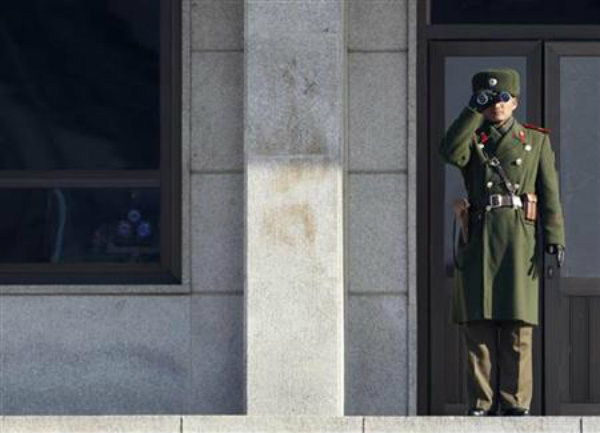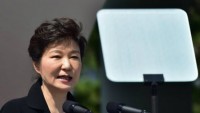Tunnel Warfare: North Korea Digs Tunnels Leading To South Korea
| Bianca Ortega | | Oct 03, 2014 03:50 AM EDT |
(Photo : Reuters / Lee Jae-Won) A North Korean soldier on the northern side of the truce village of Panmunjom looks south in the demilitarised zone that separates North Korea from South Korea in Paju, north of Seoul January 19, 2011.
South Korea discovered that North Korea sneakily dug several tunnels that led to its neighboring country, according to Gen. Hahn Sung-Chu of the South's military.
Dowsers found three tunnels with a width of approximately five meters and a depth of 12 meters, the general said. Hahn branded the act of digging the tunnels as a form of "invasion," saying North Korean soldiers were working under their territory all the while, CNN relayed.
Like Us on Facebook
Hahn said some residents reported they felt the vibrations underneath the ground, but could not justify the complaint because there is no subway running in the area.
When his team attempted to bore holes for lowering a camera, they encountered two explosions underground and the holes they drilled were blocked thereafter.
Hahn is sure North Korean soldiers were underground to protect the tunnel, the report said.
Hahn's team discovered four tunnels running from the North, but they were not present since 1990. South Korea believes there are around 20 tunnels and the Defense Ministry is still looking for the rest under the Demilitarized Zone (DMZ).
North Korea, on the other hand, denied the tunnels were built for an invasion. They are part of its mining activities, the reclusive state explained.
The Defense Ministry is convinced that North Korea could not dig a tunnel six miles (10 kilometers) beyond the DMZ because the Imjin River would get in the way. An area spanning 25 miles (40 kilometers) separates Seoul from the DMZ.
The Korean Peninsula contains a large amount of groundwater, so one must keep removing water and soil if he wants to dig a tunnel that runs tens of kilometres, Defense Ministry spokesperson Kim Min-Seok said. The digging must also be done at a proper angle, he added.
Both the U.S. and South Korea have monitored the area using aerial photos, and they did not find any evidence of the tunnel-digging, Kim said. However, a former intelligence officer from NoKor disputed this, saying soldiers from the North dug the tunnels vertically at night to avoid detection.
The official, who refused to reveal his true name to protect his family in the North, said he knew of the tunnel digging when he still lived there. He thinks Pyongyang would exert considerable effort to protect the various tunnels it dug in the last couple of decades.
"The tunnels are connected to the sewers linked to the relevant organizations," the official said.
The relevant organizations include the U.S. Embassy, Blue House and other government establishments. In case a war erupts, the North's army would run into the tunnels wearing South Korean or American uniforms and blow up the path behind them to prevent retreat.
Hahn said the South Korean government should not dismiss the threat posed by the tunnels being dug underneath their feet.
©2015 Chinatopix All rights reserved. Do not reproduce without permission
EDITOR'S PICKS
-

Did the Trump administration just announce plans for a trade war with ‘hostile’ China and Russia?
-

US Senate passes Taiwan travel bill slammed by China
-

As Yan Sihong’s family grieves, here are other Chinese students who went missing abroad. Some have never been found
-

Beijing blasts Western critics who ‘smear China’ with the term sharp power
-

China Envoy Seeks to Defuse Tensions With U.S. as a Trade War Brews
-

Singapore's Deputy PM Provides Bitcoin Vote of Confidence Amid China's Blanket Bans
-

China warns investors over risks in overseas virtual currency trading
-

Chinese government most trustworthy: survey
-

Kashima Antlers On Course For Back-To-Back Titles
MOST POPULAR
LATEST NEWS
Zhou Yongkang: China's Former Security Chief Sentenced to Life in Prison

China's former Chief of the Ministry of Public Security, Zhou Yongkang, has been given a life sentence after he was found guilty of abusing his office, bribery and deliberately ... Full Article
TRENDING STORY

China Pork Prices Expected to Stabilize As The Supplies Recover

Elephone P9000 Smartphone is now on Sale on Amazon India

There's a Big Chance Cliffhangers Won't Still Be Resolved When Grey's Anatomy Season 13 Returns

Supreme Court Ruled on Samsung vs Apple Dispute for Patent Infringement

Microsoft Surface Pro 5 Rumors and Release Date: What is the Latest?













